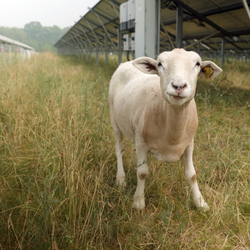Solar in Winter – Better than You May Think
Winter is coming, and for Michiganders, this may bring mixed emotions. Fond memories of sledding, skating and sipping cocoa are tempered by the search for shovels, scrapers and the blast of sub-zero temperatures.
Whatever the season has in store, rest assured our team will continue to deliver the energy our communities count on. And in the years ahead, much of the electricity powering your homes and businesses will come from the sun — even during the dark winter months with the help of battery storage.
As solar gains momentum, it is the centerpiece of our Clean Energy Plan to meet Michigan’s energy needs over the next 20 years, protecting the environment by eliminating coal and achieving net zero carbon emissions. We plan to add 8,000 megawatts of competitively bid utility-scale solar power by 2040. Worried that will use up our valuable farmlands? Think again – we expect to meet our solar energy targets using less than 2% of Michigan’s farmland.
 Why the focus on solar?
Why the focus on solar?
In addition to its environmental benefits, solar is increasingly cost-competitive and we can add it gradually to meet Michigan’s changing energy needs without building a large, expensive fossil fueled plant. We are developing solar power plants now and searching for large parcels of land for future sites. If you have a site for us to consider, please see our Solar Power and Landowners page.
Solar also offers strong economic benefits to local communities. For example, Michigan’s Renewable-Ready Communities program offers $5,000 per megawatt of installed capacity to communities that host renewable energy resources. This is in addition to revenue from traditional taxation or payment in lieu of taxes (PILT), an option where the project owner pays the community a fixed annual payment based on the capacity of the solar power plant.
But can solar power stand up to the toughest Michigan winters? Let’s look at the common misconceptions and how we expect our next generation of power plants to withstand extreme wintry conditions.
Can solar power work in the winter?
Yes. Solar panels are built to keep generating clean, renewable energy throughout the winter. In fact, they’re designed to perform most efficiently as temperatures drop. The best solar production is often in later winter when the combination of cold air and clear skies is perfect for producing power.
To get into the nitty gritty of how they work, most of our solar panels will be on single-axis trackers, meaning they’ll rotate throughout the day to capture the maximum amount of sunlight. Even in cloudy conditions throughout the year, irradiance hitting the solar panels generates electricity.
Do solar panels work in snow?
They sure do. A light dusting is no big deal for solar panels. In the case of a larger storm, the single-axis tracking system can tilt the panels to a steep angle that sheds snow. When the sun is out, panels also can absorb infrared heat quickly to melt snow and ice much faster than the ground or a typical rooftop. Also, snow on the ground reflects light onto the back of the modules to produce power.
How cold is too cold for solar panels?
Colder temperatures enhance production efficiency, meaning a chilly and sunny winter day is optimal for solar energy. Panels are tested at low temperatures to verify longevity and durability in all weather conditions – including wind, rain, hail, snow and varying humidity. So, it’s safe to say solar panels can tough out even some of the most intense Michigan snowstorms.